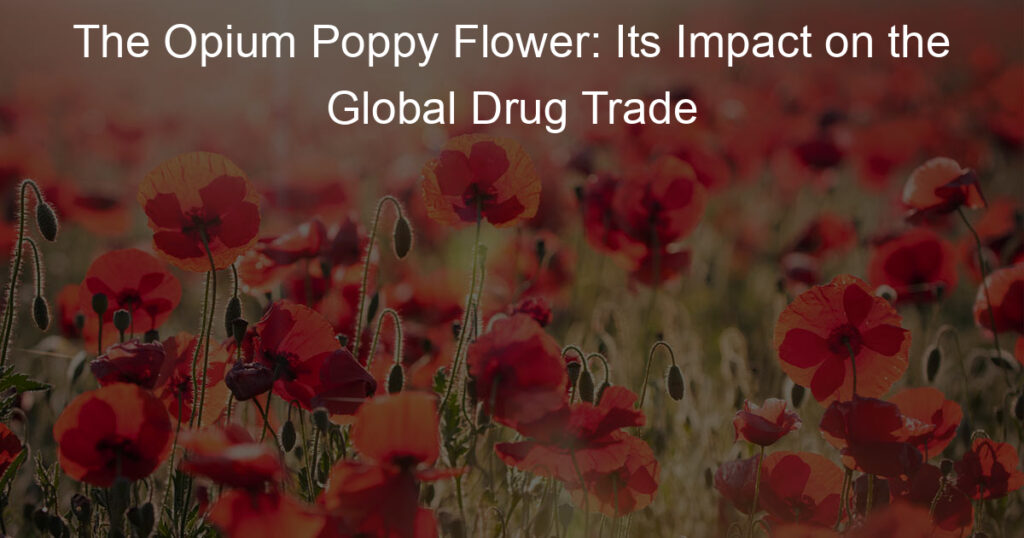The opium poppy flower is one of the most beautiful, yet controversial flowers in the world. The delicate petals have been associated with both relaxation and addiction for centuries, and today, the global drug trade is still largely dependent on this tiny flower. In this blog post, we’ll take a closer look at the opium poppy flower and its impact on the world around us.
What is the opium poppy flower?
The opium poppy flower is arguably one of the most beautiful and intriguing flowers in existence. With its striking bold petals and range of colors, it can make for quite an eye-catching sight in any garden or field! But what many may not know is that along with being lovely to look at, the opium poppy flower is also a powerful drug source.
For centuries, people around the world have used opium extracted from these flowers as a medication for a variety of ailments, but more often than not as an addictive recreational drug. While it has caused countless problems throughout history, the growth and medical use of the opium poppy flower continue to this day.
How is opium extracted from the poppy flower?
Opium extraction from the poppy flower is a process that requires specialized equipment and knowledge. The scientific name for the poppy flower is Papaver somniferum, which relates to its deep connection with sleep. This species of wild or cultivated poppy flowers are harvested for both medicinal and recreational uses. In the extraction process, an incision is made into the seed capsule inducing a milky sap to flow out. As the sap comes out, it thickens as it flows from the capsule within a few minutes and hardens upon contact with air to form opium gum, which is then scraped off of the flower.
Though not commonly done anymore due to modern equipment, in the past people used their fingernails or coins to scrape them off for use in medications and artificial opiates like morphine and codeine. This process has been around for thousands of years, yet even today continues to be utilized by many around the world who don’t have access to more technologically advanced methods of producing medicinal opiates.
What are some of the medical uses of opium?
Opium is a powerful pain reliever that has been used for medical purposes for centuries. It can be used to treat patients suffering from conditions such as severe pain, coughing, diarrhea, and insomnia. An opium derivative known as codeine is a component of many widely available cough syrups and analgesics. Morphine, another alkaloid derived from opium, is often used to provide relief from post-operative pain and other severe forms of chronic pain that are not affected by other drugs.
Opioid analgesics are strong medications designed to reduce discomfort associated with acute or chronic pain. They work by affecting certain opioid receptors in the brain and spinal cord. When prescribed correctly and taken properly, these medications can be effective in controlling high levels of intense pain.
How is opium used illicitly in the global drug trade?
Opium has been a powerful presence in the global drug trade for centuries, used both licitly and illicitly. Today, it is primarily used by shadowy underground networks as a source of opioids such as codeine, morphine, and heroin. Illicit opium production has recently spread from its traditional origins in Afghanistan and South Asia to Latin America and Africa, creating an ever-growing market that relies on organized crime foundations.
From poppies in the poppy fields to syringes bought on the streets, opium forms part of a complex network of exploitation driven by demand for its chemical compounds. With decriminalization seeming far away and police tools overstretched, tackling this problem remains a serious challenge for nations around the world.
What is the history of opium cultivation and trade?
The history of opium cultivation and trade stretches back thousands of years, having been a part of various civilizations from Asia to Europe. Initially, a medicinal herb used for pain relief, it wasn’t until the British began actively trading it in the early 19th century that opium became exported for recreational purposes. This sparked the Opium Wars between China and Britain, the latter attempting to force its opium onto Chinese markets.
Despite those wars ending in 1842, the addiction crisis in China was far-reaching due to their growing demand for and access to the drug. Since then, opioids have made appearances and have had effects on almost every corner of our planet, surely making this one of the oldest industries that still heavily influences our lives today.
Which countries are the largest producers of opium?
Opium, a derivative of poppy plants, has been cultivated and used as pain relievers and as recreational drugs for thousands of years. Currently, the illegal cultivation, production, and trafficking of opium continue to be a major problem across the world. The top three countries that are the largest producers of this narcotic are Afghanistan, Myanmar (Burma), and Mexico.
Although historically these three countries have produced large quantities of opium since the late 1990s, Afghanistan is by far the leading country in terms of statistics on illicit opium cultivation with 87 percent of all global supply coming from its land. Subsequently, despite international efforts to eradicate opium cultivation in Myanmar and Mexico, drug traffickers continue to divert a large portion of their resources to bolster this activity to increase their profits.
Final Thoughts
The opium poppy is a flower with a long and complicated history. For centuries, it has been used to make various drugs, including morphine and heroin. Today, the majority of the world’s opium is still produced in Afghanistan, where it plays a major role in the country’s economy. Despite efforts to crack down on the illicit drug trade, the demand for opioids remains high all over the world. As a result, the cultivation of opium poppies is likely to continue for years to come.














